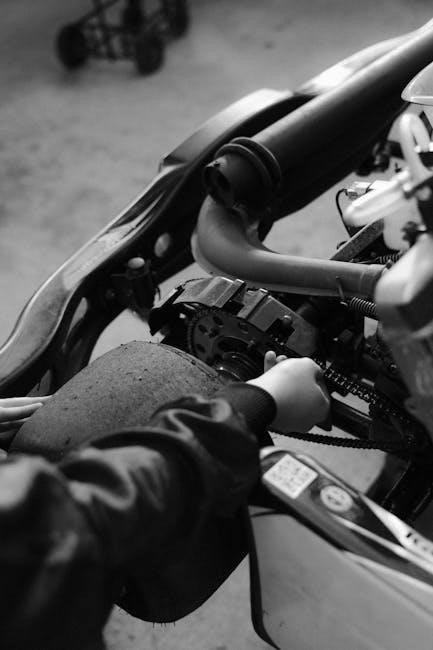Smart car technology integrates advanced systems for enhanced performance, safety, and environmental sustainability․ This manual provides detailed insights into its features, ensuring optimal utilization and maintenance of your vehicle․
1․1 Overview of Smart Car Systems
Smart car systems integrate advanced technologies like maintenance-free engines, sensors, and multimedia interfaces․ These systems enhance performance, efficiency, and safety while reducing environmental impact․ The manual details these components, ensuring users understand and utilize them effectively․ Proper maintenance and operation are emphasized to maximize vehicle longevity and functionality․ By following the guidelines, drivers can enjoy a seamless and sustainable driving experience․ The manual serves as a comprehensive guide to unlocking the full potential of smart car technology․ It ensures both safety and efficiency, catering to modern automotive needs․
1․2 Importance of a Smart Car Manual
A smart car manual is essential for understanding and optimizing your vehicle’s advanced features․ It provides critical information on maintenance, safety, and troubleshooting, ensuring optimal performance․ The manual serves as a comprehensive guide, helping users navigate complex systems and technologies․ By following its instructions, drivers can enhance safety, reduce environmental impact, and extend the vehicle’s lifespan․ The manual also offers insights into new technologies, empowering users to make informed decisions․ It is a vital resource for both novice and experienced drivers, ensuring a seamless and efficient driving experience․

Key Features of a Smart Car Manual
A smart car manual offers maintenance-free engine insights, advanced sensor technology, and Smart Guides app integration, ensuring efficient, safe, and informed vehicle operation and ownership experiences․
2․1 Maintenance-Free Engine Systems
Maintenance-free engine systems in smart cars minimize hazardous emissions and optimize performance․ These systems reduce soot particles, contributing to environmental protection․ Advanced sensors monitor engine temperature, gearbox status, and braking performance, ensuring smooth operation․ The smart car manual highlights how these systems eliminate the need for frequent manual checks, enhancing reliability and reducing maintenance costs over time․
Such innovations ensure a cleaner, more efficient driving experience while adhering to eco-friendly standards․ Regular updates and diagnostics are handled automatically, making vehicle ownership hassle-free․ This approach aligns with modern demands for sustainable and low-maintenance transportation solutions․
2․2 Advanced Sensor Technology
Advanced sensor technology in smart cars plays a crucial role in monitoring and optimizing vehicle performance․ These sensors continuously track key components such as engine temperature, gearbox status, and braking systems․ By analyzing real-time data, they ensure smooth operation and prevent potential issues before they occur․ This proactive monitoring enhances safety, reduces wear and tear, and contributes to a cleaner environmental footprint․ The integration of these sensors aligns with the smart car manual’s focus on efficiency, reliability, and eco-friendly driving experiences․
2․3 Smart Guides App Integration
The Smart Guides App offers seamless integration with your vehicle, providing instant access to essential information․ Through this app, you can view detailed guides, maintenance schedules, and multimedia system controls directly on your smartphone․ It allows for online or offline access, ensuring convenience and connectivity․ The app is designed to enhance your driving experience by offering real-time updates and troubleshooting tips․ Compatible with various devices, the Smart Guides App serves as a comprehensive digital companion for smart car owners, simplifying vehicle management and fostering a more informed driving experience․

Safety and Operational Guidelines
Adhere to safety practices and proper vehicle handling to ensure optimal performance․ Regular maintenance and inspections are crucial for long-term reliability and passenger safety․
3․1 Safety-Related Work Recommendations

Always follow safety-related work recommendations to ensure your vehicle operates securely․ Bring your car to an authorized service center for inspections and maintenance, especially for safety-critical systems․ This includes regular checks on brakes, tires, and electrical components․ Neglecting these can lead to reduced performance and potential hazards․ Use genuine parts and adhere to the manual’s guidelines to maintain reliability and safety standards․ Proper maintenance not only extends your vehicle’s life but also protects you and others on the road․
3․2 Proper Operating Conditions
Proper operating conditions are essential for optimal performance and safety․ Ensure your vehicle is maintained according to the manual’s guidelines, including checking fluid levels, tire pressure, and battery health․ Avoid extreme temperatures and ensure all systems are within specified ranges․ Regularly update your vehicle’s software and use the Smart Guides app to monitor conditions․ Adhering to these practices enhances reliability, reduces emissions, and ensures a smooth driving experience while protecting the environment․
3․3 Anti-Theft System Features
Your smart car is equipped with an advanced anti-theft system designed to protect your vehicle from unauthorized access․ This system includes features like an immobilizer, which prevents the engine from starting without the correct key, and encrypted key technology for added security․ Additionally, the car may feature a sophisticated alarm system that triggers in case of forced entry or tampering․ Regular updates to the system, as outlined in the manual, ensure optimal performance and enhanced protection against theft․ Always follow the manual’s recommendations to maintain your car’s security․

Vehicle Indicators and Warning Lights
Vehicle indicators and warning lights monitor driving conditions, alerting you to issues like low beams, high beams, coolant temperature, and system faults, ensuring safe operation always․
4․1 Low and High Beam Indicator Lamps
The low and high beam indicator lamps provide visual confirmation of your headlights’ status․ The low beam indicator, often green, ensures proper visibility during nighttime driving․ The high beam indicator, typically blue, activates when bright lights are on, aiding in distance illumination․ These indicators help maintain road safety by ensuring appropriate light usage․ Proper functionality is crucial for other drivers’ visibility and your own safety․ Always check these indicators to avoid accidents and ensure compliance with traffic regulations․
4․2 Fault Warning Lamps
Fault warning lamps are essential for monitoring your vehicle’s health․ These indicators, often yellow, illuminate when the system detects issues such as engine malfunctions or sensor failures․ They provide immediate alerts, ensuring timely attention to potential problems․ Always investigate the cause if a fault lamp activates, as ignoring it may lead to further damage․ Refer to your smart car manual for specific lamp meanings and troubleshooting steps to address the issue promptly and safely․
4․3 Coolant Temperature Warning Systems
The coolant temperature warning system monitors engine temperature, ensuring it stays within safe limits․ A warning lamp illuminates if the temperature rises excessively, signaling potential overheating․ Addressing this promptly prevents engine damage․ Check the manual for procedures to safely cool the engine and identify causes, such as low coolant levels or radiator issues․ Ignoring this warning can lead to severe engine damage, so always take immediate action to maintain your vehicle’s health and performance․

Maintenance and Service Instructions
Regular maintenance ensures optimal performance and longevity․ Follow guidelines for oil changes, tire rotations, and scheduled services to keep your smart car in top condition․
5․1 Scheduled Maintenance Requirements
Scheduled maintenance is crucial for ensuring your smart car operates efficiently and safely․ Regular oil changes, filter replacements, and tire rotations are essential․ Consult your manual for specific intervals tailored to your vehicle’s needs․ Additionally, inspect brakes, battery, and belts as recommended․ Adhering to these schedules prevents potential issues and extends the lifespan of your car․ Always follow the guidelines provided by authorized service centers to maintain optimal performance and environmental benefits, such as reduced emissions․ Proper maintenance also enhances safety and overall driving experience․
5․2 Oil Changes and Filter Replacements
Regular oil changes and filter replacements are vital for maintaining your smart car’s engine health․ Typically, oil changes are recommended every 5,000 to 7,500 miles, depending on driving conditions․ Use synthetic oil for optimal performance and engine protection․ Always refer to your manual or the Smart Guides app for specific intervals and guidelines․ Neglecting these services can lead to reduced fuel efficiency, increased emissions, and potential engine damage․ Ensure replacements are done by authorized professionals to maintain warranty validity and overall vehicle performance․
5․3 Tire Rotations and Handling Tips
Regular tire rotations are essential for ensuring even wear and extending the life of your tires․ Typically, rotate tires every 5,000 to 8,000 miles, following the pattern recommended in your manual․ Proper tire pressure and alignment are also critical for optimal handling and fuel efficiency․ Always check tire pressure when tires are cold, and refer to the Smart Guides app for specific guidelines․ Improper handling or neglecting rotations can lead to uneven wear, reduced traction, and increased risk of tire failure, compromising safety and performance․

Multimedia and Entertainment Systems
The Smart Media-System offers advanced entertainment features, seamlessly integrating with the Smart Guides app for easy access to multimedia controls and vehicle information, enhancing your driving experience․
6․1 Operating the Smart Media-System
The Smart Media-System offers a user-friendly interface for managing multimedia features․ Access music, navigation, and vehicle information through intuitive controls․ The system integrates seamlessly with the Smart Guides app, allowing you to download or stream content directly to your vehicle․ Use voice commands or touchscreen inputs for hands-free operation․ Ensure your device is connected via Bluetooth or USB for optimal functionality․ Refer to the interactive manual for detailed instructions on customizing settings and troubleshooting common issues; Proper operation enhances your driving experience, ensuring safety and entertainment on the road․
6․2 Multimedia Features and Controls
The multimedia system includes features like high-definition displays, Bluetooth connectivity, and voice recognition․ Controls are conveniently located on the steering wheel and dashboard for easy access․ Customize audio settings, navigate through menus, and manage connected devices effortlessly․ The system supports various file formats and integrates with smartphones for seamless connectivity․ Use the Smart Guides app to explore additional functionalities and updates․ Proper use of these controls ensures a safe and enjoyable driving experience while maintaining focus on the road․

Additional Features and Technologies
Additional features include cruise control for steady speed, anti-theft systems for security, and manual headlamp mode for customizable lighting, enhancing convenience and safety․
7․1 Cruise Control Functionality
Cruise control allows drivers to maintain a constant speed, reducing fatigue on long trips․ It can be activated using steering wheel controls, with speed adjustments made effortlessly․ The system automatically deactivates when brakes are applied, ensuring safety․ This feature enhances driving comfort and convenience, especially on highways․ Proper use is detailed in the manual to ensure optimal functionality and safe operation․ Always refer to the guide for specific instructions tailored to your vehicle model․
7․2 Manual Headlamp Mode Maintenance
Manual headlamp mode allows drivers to control high and low beams manually for improved visibility in various driving conditions․ The system includes indicator lamps that show the current beam status․ Proper maintenance involves regular bulb checks and alignment to ensure optimal light output․ The manual provides detailed steps for adjusting headlamps and replacing bulbs․ Always consult the guide for specific maintenance instructions to maintain safety and performance․ Regular checks help prevent issues and ensure compliance with road safety standards․

Environmental Benefits
Smart car technology reduces emissions and fuel consumption, promoting sustainability․ Advanced systems optimize energy use, lowering environmental impact while maintaining performance and efficiency for eco-conscious driving experiences․
8․1 Emission Reduction Technologies
Emission reduction technologies in smart cars include advanced engine systems that minimize hazardous soot particles and reduce greenhouse gas emissions․ These technologies contribute to environmental protection by optimizing fuel combustion and lowering exhaust pollutants․ Regular maintenance, as outlined in the manual, ensures these systems operate efficiently, promoting cleaner air and a sustainable future for urban environments․ By adhering to scheduled service recommendations, drivers can maximize their vehicle’s eco-friendly performance and support global efforts to combat climate change through reduced emissions․
8․2 Fuel Consumption Optimization
Fuel consumption optimization in smart cars is achieved through advanced engine systems and maintenance-free technologies that enhance efficiency․ Regular servicing, as outlined in the manual, ensures optimal performance by monitoring factors like tire pressure and driving habits․ Proper operating conditions, such as avoiding excessive idling, also play a crucial role in minimizing fuel waste․ By following these guidelines and utilizing tools like the smart guides app, drivers can achieve better mileage and reduce their environmental impact while lowering operational costs over time․

Troubleshooting and Technical Support
Troubleshooting common issues and accessing technical support ensures your smart car runs smoothly․ Refer to the manual for solutions or contact authorized service centers for assistance․
9․1 Common Issues and Solutions
Common issues with smart cars include fault warning lamps, low beam indicator malfunctions, and connectivity problems with the Smart Guides app․ Solutions often involve resetting systems, checking connections, or updating software․ For instance, if fault lamps illuminate, consult the manual or contact authorized service centers․ Connectivity issues can usually be resolved by reinstalling the app or restarting your device․ Regularly updating your car’s software and app ensures optimal performance and minimizes glitches․ Always refer to the troubleshooting section of the manual for detailed step-by-step solutions․
9․2 Contacting Authorized Service Centers
For any maintenance or repair needs, it is essential to contact authorized smart service centers․ These centers are equipped with the latest tools and expertise to handle your vehicle․ You can find a list of authorized centers in your area through the Smart Guides app or the owner’s manual․ Always carry your Scheduled Maintenance Guide when visiting a service center to ensure all necessary checks are performed․ Authorized centers guarantee genuine parts and trained technicians, ensuring your smart car receives the best care for optimal performance and safety․
Adhering to your smart car manual ensures optimal performance, safety, and efficiency․ Regular updates and proper maintenance will extend your vehicle’s life and enhance driving experiences․
10․1 Long-Term Vehicle Health
Maintaining your smart car’s health involves regular check-ups and adhering to the manual’s guidelines․ Scheduled maintenance ensures optimal engine performance, reduces emissions, and prevents costly repairs․ Proper handling of systems like brakes and tires extends their lifespan․ Staying updated with the latest software and technological advancements keeps your vehicle running efficiently․ By following the manual’s recommendations, you can ensure long-term reliability and performance, making your smart car a sustainable and trustworthy companion for years to come․
10․2 Staying Updated with Smart Car Technology
Staying updated with smart car technology ensures your vehicle remains efficient, secure, and futuristic․ Regular software updates enhance performance and safety features, while the Smart Guides app provides real-time information․ By following the manual’s guidelines, you can easily access the latest advancements, such as improved multimedia systems and emission-reducing technologies․ Keeping your car updated not only boosts its longevity but also ensures you enjoy cutting-edge innovations for a smarter driving experience․ Regular checks and updates are essential to maintain your vehicle’s peak condition and adapt to evolving technological standards․
